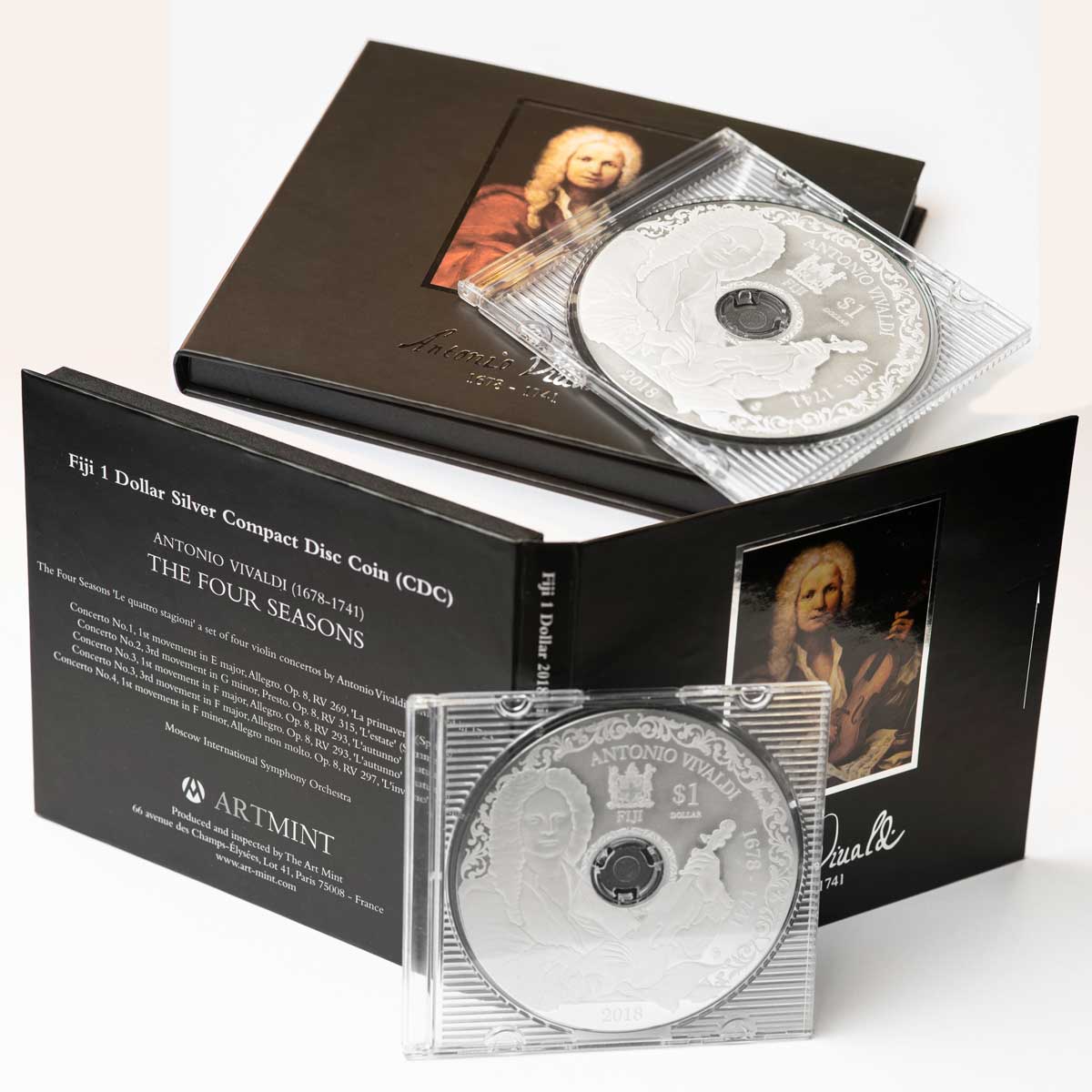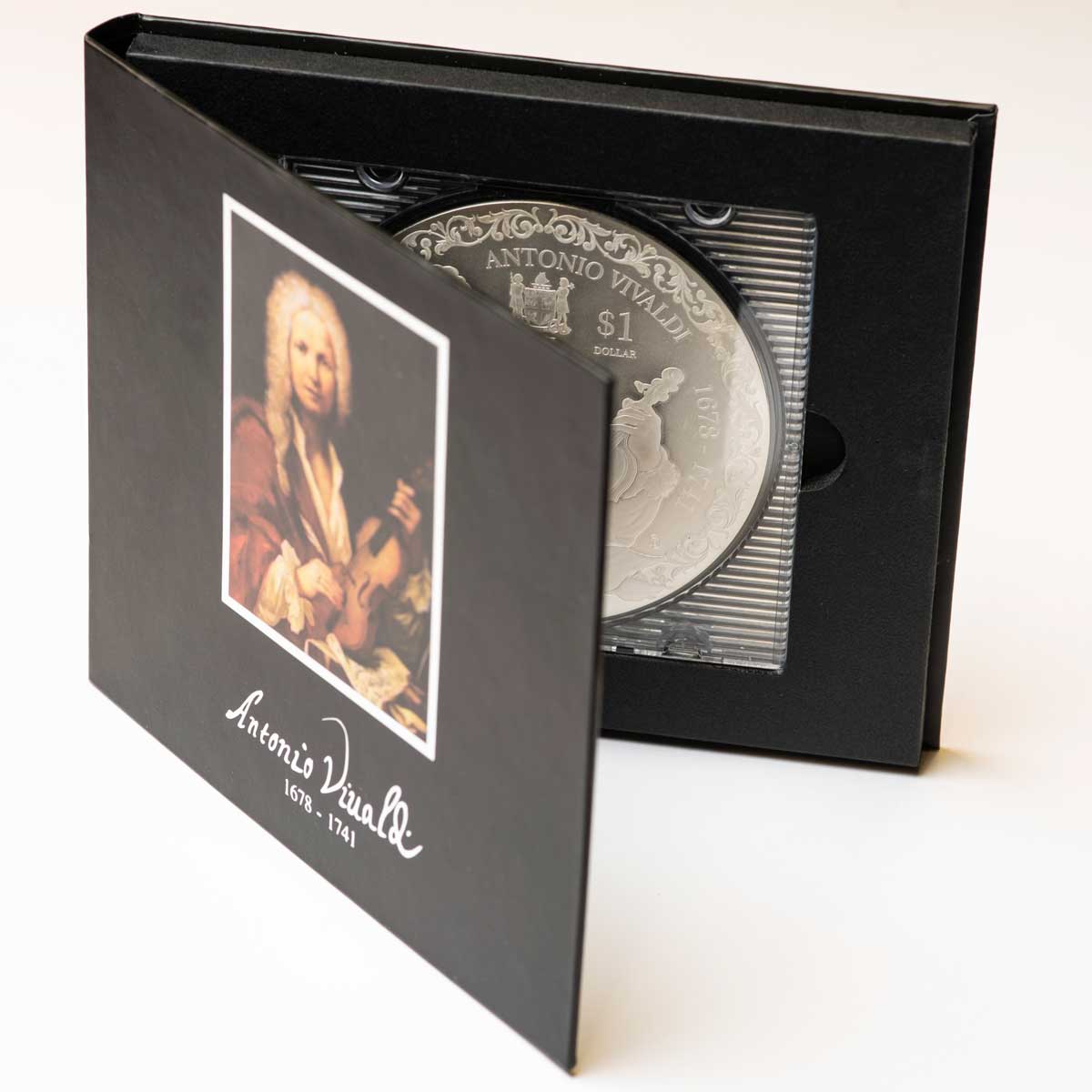Think you’ve seen it all? Think again. Art Mint releases a silver, playable classical music CD coin
One thing that has characterised the modern collectable coin market has been the increased use of technology to enhance just what can be done. In most cases, that has led to levels of design and relief which were quite unthinkable on a mass scale just a decade or so ago. Likewise, there’s been a greatly increased willingness to push the market past the simple metal disc, to encompass a whole host of adornments. Some are polarising, with collectors often preferring to stick with an unmodified, cleanly struck metal disc, but an increasing part of the market, and probably one of the reasons the hobby has maintained a good level of popularity in an increasingly coin-less world, is experimentation by mints.
Now, Art Mint have always produced coins of a very high quality, such as the beautiful Mandala Art series, and the recent Carpe Diem coin, but their latest issue is something quite different. The rise of techniques like smartminting means that wide diameters are no longer out of the ordinary, but even so, this half-ounce silver coin stretching out to an impressive 78.0 mm is quite something. It manages that by eschewing an obverse, that giving way to a Compact Disc.
The reverse face looks like a traditional silver coin, carrying an image of the composer Vivaldi holding a violin, surrounded by some Baroque-style tracery. Also on this face are all the inscriptions that would normally sit on the obverse, but Art Mint have kept them well placed and unobtrusive. As you may have guessed from this design, the music on the fully playable CD obverse is by this remarkable composer – the outstanding ‘Four Seasons’. A breathtaking piece of music, even non-fans of classical music will recognise it from many movies, including the powerful death scene in the 1973 Charlton Heston sci-fi movie, Soylent Green.
Presentation is fittingly reminiscent of a CD and the whole thing is a highly original melding of minting technology with a functional digital item. It isn’t a release for everyone, of course, and that’s reflected in the 700 mintage, but this industry is all the better for producers pushing out in new and unique ways, and we should all appreciate that. Available to order now, it should ship in November.
VIVALDI AND HIS ‘FOUR SEASONS’
Antonio Lucio Vivaldi (4 March 1678 – 28 July 1741) was an Italian Baroque musical composer, virtuoso violinist, teacher, and priest. Born in Venice, the capital of the Venetian Republic, he is regarded as one of the greatest Baroque composers, and his influence during his lifetime was widespread across Europe. He composed many instrumental concertos, for the violin and a variety of other instruments, as well as sacred choral works and more than forty operas. His best-known work is a series of violin concertos known as the Four Seasons.
Many of his compositions were written for the all-female music ensemble of the Ospedale della Pietà, a home for abandoned children. Vivaldi had worked there as a Catholic priest for 1 1/2 years and was employed there from 1703 to 1715 and from 1723 to 1740. Vivaldi also had some success with expensive stagings of his operas in Venice, Mantua and Vienna. After meeting the Emperor Charles VI, Vivaldi moved to Vienna, hoping for royal support. However, the Emperor died soon after Vivaldi’s arrival, and Vivaldi himself died, in poverty, less than a year later.
The Four Seasons is a group of four violin concerti, each of which gives musical expression to a season of the year. They were written around 1716–1717 and published in 1725 in Amsterdam, together with eight additional concerti, as Il cimento dell’armonia e dell’inventione (The Contest Between Harmony and Invention). They were a revolution in musical conception: in them Vivaldi represented flowing creeks, singing birds (of different species, each specifically characterized), a shepherd and his barking dog, buzzing flies, storms, drunken dancers, hunting parties from both the hunters’ and the prey’s point of view, frozen landscapes, and warm winter fires.
Unusually for the period, Vivaldi published the concerti with accompanying sonnets (possibly written by the composer himself) that elucidated what it was in the spirit of each season that his music was intended to evoke. The concerti therefore stand as one of the earliest and most detailed examples of what would come to be called program music—i.e., music with a narrative element. Vivaldi took great pains to relate his music to the texts of the poems, translating the poetic lines themselves directly into the music on the page. For example, in the middle section of “Spring”, when the goatherd sleeps, his barking dog can be heard in the viola section. The music is elsewhere similarly evocative of other natural sounds. Vivaldi divided each concerto into three movements (fast–slow–fast), and, likewise, each linked sonnet into three sections.(Source: Wikipedia)
| SPECIFICATION | |
| DENOMINATION | $1 Fiji |
| COMPOSITION | 0.999 silver |
| WEIGHT | 15.5 grams |
| DIMENSIONS | 78.0 mm |
| FINISH | Proof-like |
| MODIFICATIONS | Playable CD obverse |
| MINTAGE | 700 |
| BOX / C.O.A. | Yes / Yes |







Leave A Comment